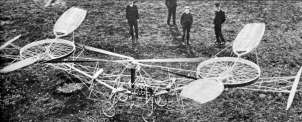
""
PAUL
CORNU
CORNU |


|
|
|
Paul Cornu, nació en Francia el 15 de junio de 1881, y mientras trabajaba en la construcción de bicicletas, proyectó un motor rotativo de petróleo, un triciclo de vapor y en 1904 un automóvil con dos motores independientes. En 1905 solicitó una patente para "un sistema de propulsión y de dirección para aparatos de planos giratorios". El 4 de octubre de 1906 ensayo con un aparato equipado con un motor Buchet de 2 hp, este aparato pesaba 13 Kg y durante las pruebas levanto 16 Kg. Prosiguió sus pruebas con la esperanza de ganar el premio Deutsch-Archdeacon (50000 francos para el primer vuelo de 1 Km en circuito cerrado) y por lo tanto construyó un aparato en tamaño natural comenzando los trabajos en diciembre de 1906. El 31 de agosto de 1907 efectúo un despegue vertical con un saco de arena simulando el peso del piloto. El día 13 de noviembre de 1907, y ya con un piloto al mando, el helicóptero equipado con un motor Antoinette y con un peso de 260 Kg. se elevó 30 cm., y el mismo día durante un segundo ensayo se elevo 1,50 metros levantando a ambos hermanos Cornu (el hermano se había sujetado de la parte delantera del chasis), con lo cual sostuvo un total de 328 Kg.. Poco después trató de obtener ayuda para la construcción de un aparato mayor, pero no obtuvo eco y debió abandonar sus trabajos por falta de ayuda financiera. Falleció el 6 de junio de 1944 bajo los escombros de su casa destruida por los bombardeos precursores del desembarco de Normandía. |
|
|
|
Shortly after the Wright brothers’ first successful powered flights with fixed-wing airplanes at Kitty Hawk in the United States in 1903, two wealthy French industrialists ofrered a prize of fifty-thousand French Francs to the first pilot who could fly an aircraft around a one kilometer closed circuit. A fierce competition began for the Deutch-Archdeacon Grand Prix prize, as it was known, and the innovative aircraft designs that ensued contributed greatly the development of European aviation. One aircraft was designed by a French
bicycle maker named Paul Cornu, who during the period 1906-07
constructed a helicopter that is claimed to have carried a human of the
ground for the very first time. Nearly every book and article written on
the history of the helicopter makes this claim. However, it is
interesting to objectively review the potential performance of Cornu’s
vertical flight machine. Jean Boulet, in his book History of the
Helicopter gives a detailed account of Paul Cornu’s work, citing
many technical details of his machine, as reported in Cornu’s original
article in L’Aerophile of 15 April 1908. The photographs of
Cornu’s machine show a skeletal airframe of very simple construction
and relatively light-weight, being constructed of a 20-foot length of
steel beam bent into a wide U-shape, with six “star” frames all tied
together with Bowden cables. A rotor was mounted at each end of the main
structural beam. The rotors rotated in opposite directions, a necessary
requirement to cancel torque reaction. The inner hub part of each rotor
looked like large bicycle wheels, which may not be surprising
considering the inventor’s profession. At the periphery of each rotor,
there were two light, wide chord, fabric covered blades. Power was
supplied to the rotors by a 24 hp Antoinette gasoline motor through a
belt and pulley transmission, a mechanism that it seems caused Cornu
many problems and much frustration. A primitive means of control was achieved by
placing a “plane” or a wing in the slipstream below each of the
rotors, the inclination and force on the these wings was controlled by
the pilot with two hand operated levers. On December 4 1907, Cornu’s
“flying bicycle” was reported to have made several tethered flights
of a few minutes at low altitude. In Cornu’s own words: “...the
aircraft left the ground with four wheels all together...”. The feat
was reportedly witnessed by persons on the ground, but no supporting
photographs of his flights have ever been produced. |
|
|
|
Characteristics |
Information |
Characteristics |
Information |
| First
Flight Primer Vuelo |
1907 |
Engine Motor |
1 Antoinette |
| Seating
Capacity Plazas |
1 |
Power Potencia |
24 HP |
| Empty
Weight Peso Vacío |
Lb |
Hover
Ceiling O.G.E. Estacionario O.G.E |
Ft |
| Maximum
Weight Peso Máximo |
575 Lb |
Hover
Ceiling I.G.E. Estacionario I.G.E |
Ft |
| Vel.
Cruise Vel. crucero |
Kts |
Service
Ceiling Techo de Servicio |
Ft |
| V.N.E. V.N.E |
Kts |
Maximum
Range (Std) Alcance (Std) |
NM |
Copyright © 1999 / 2003